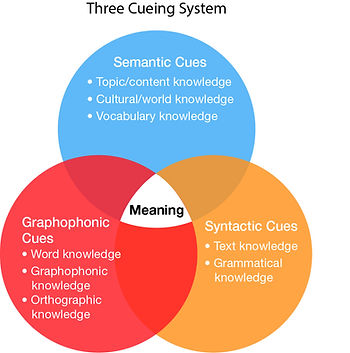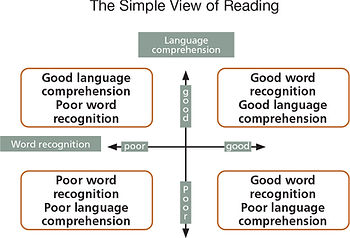How to knock down five strawman arguments against phonics
How to knock down five strawman arguments against phonics

The lack of direction on how to effectively teach reading leaves many pre-service teachers unsure of where to start. Here, fellow teacher John Kenny shares what he has learned in the years since he completed his own initial teacher education.
By John Kenny
Four Corners recently aired a report on education that featured the Reading Wars. The report itself did not surprise me much. It summarised the arguments of both sides in typical fashion. What really got my interest were the comments made by pre-service teachers interviewed for the piece. One pre-service teacher made comments on his teaching degree that made it clear the information he is receiving is vague. He said that he felt his teaching degree wasn’t giving much direction on how to actually teach kids how to read:
“I know at university, we’re taught a whole abundance of approaches to teaching reading and writing, but we’re not necessarily taught which one works. I think the reason for that is that people don’t know.”
I think his comments are very insightful because, at that very point in my career, I did not have the awareness to make judgements about my degree – my opinions were pretty staunchly aligned with the opinions of my lecturers. I’m happy to pitch a guess that most pre-service teachers are like me; the pre-service teachers in the report are likely exceptions.
The pre-service teachers gave me much hope that there are new teachers out there that are hungry to learn how to teach kids to read effectively. If you are a pre-service or new teacher, and your curiosity has brought you to this article, then you need to know that you don’t know nearly enough to teach reading properly. Yes, that is scandalous, and yes, you have the right to be upset about it. I also spent $$$ to learn very little. In the years since finishing, I have learnt enough to feel confident in my practice (though I still have much to learn!). There are some things worth knowing to get you started on your journey to becoming a good teacher of reading. Let me help you out by pointing you in the right direction.
Why bother?
In case you’re still not convinced that diving deep into the world of evidence-based reading instruction is necessary, then you should take the time to read this paper by three people who really do know their stuff. It’s tough reading; at least, I felt it was very hard to read when I first encountered it, for I did not want to admit that I did not know enough. I implore you to read it. Find motivation in it. You will feel so much more fulfilled once you realise you’ve got a ways to go, that you can gain the knowledge you need to improve your practice and gain the best possible outcomes for the kids you teach.
One of the authors of the paper above also recently did research into whether or not teacher education courses are giving their students the knowledge they need about effective reading instruction. The results were not encouraging. It’s worth your time.
It’s best if you move away from poor ideas
Having gone through initial teacher education, I have no doubt you have been introduced to the Three Cueing System.

You need to know that this model does not align with research on reading and that you should move away from it as soon as possible. The Simple View of Reading is widely accepted as a good starting point for thinking about how students learn to read. You should move away from the Three Cueing System and begin to study the Simple View.

The Simple View of Reading shows us that, while reading is a complex task, it can be represented as two independent processes: word recognition (decoding) and language comprehension. Skilled reading is actually a combination of these two processes. Decoding is the ability to get the words off the page accurately and fluently, and language comprehension is the ability to make sense of what is being communicated. If a student is deficient in either of these, then reading difficulties will arise.
Treating reading like a combination of two separate processes means that we also need to teach the two processes separately. When students first come to school, they have few, if any, word recognition skills. This is why the evidence base recommends focusing on strengthening word recognition skills right away while simultaneously and separately building students’ language comprehension through vocabulary, knowledge building, oral language and book exposure.
Whole Language and (so-called) Balanced Literacy advocates reject this evidence-based view of reading because they believe that reading words cannot be separated from ‘meaning’. They believe students can grasp the meaning of texts without actually being able to decode words as reading is a ‘meaning-making process’. The Three Cueing System says students should figure out words using ‘semantic’ and ‘syntactic’ cues before relying on graphophonic cues (graphophonic isn’t a word, btw. They mean using phonic knowledge). This approach has been debunked by reading research and should be put to bed. As I’ve written previously, it’s actually worse than that: reading research has shown that this approach teaches the habits of poor readers. It’s not just that the Three Cueing approach isn’t correct, it’s actually completely and utterly backwards. The research strongly indicates that the Simple View really is the correct way to think about how students come to read: two processes that converge into skilled reading.
Scarborough’s Reading Rope (2001)
.jpg)
Republished with permission of Guilford Publications, from ‘Connecting early language and literacy to later reading (dis)abilities: evidence, theory and practice’, Handbook of early literacy research, Vol 1, pp. 97–110, 2001; permission conveyed through Copyright Clearance Center, Inc.
Since the publication of Gough and Tunmer’s 1986 paper, researchers have worked to expand on the Simple View of Reading. One often-cited model that expands and builds on the Simple View is Scarborough’s Reading Rope. The ‘rope’ breaks reading down into its two processes – word recognition and language comprehension – and expands on them to give a neat breakdown of the component parts of the two processes. This model does a great job of showing how complex the Simple View really is – it is simple, but not simplistic.
Get familiar with phonics, but not ‘just phonics’
How students come to get the words off the page – the ‘word recognition’ side of the Simple View – is the battlefront of the Reading Wars. Research has found that synthetic phonics, an approach where students are taught letter-sound correspondences in isolation and then taught to synthesise the sounds to read words, is the most effective way to teach word recognition skills. Whole Language advocates totally reject the evidence base for the efficacy of synthetic phonics. Within the evidence-based community, to reject synthetic phonics is akin to being a flat-Earther. Yet you will hear many on the Whole Language side disparage the approach as overly simplistic rote learning. That it is not. It is systematic, engaging, explicit and difficult to teach well. The evidence for it is very convincing. The debate around the efficacy of synthetic phonics is one where a lot of misinformation is thrown around, so I encourage you to dig a little deeper to get to grips with the facts of this approach.
Although phonics is rightfully at the forefront of the debate (it’s not taught very well, so evidence-based advocates push hard for change in that area), it’s important to note that it is not the only area that needs to be taught explicitly and systematically. The reading research actually identifies five components, or ‘keys’, of reading instruction that need to be taught in this way. The five keys are phonics, phonemic awareness, fluency, vocabulary and comprehension.
That pre-service teachers do not hear about the five keys in their courses is evidence enough that something isn’t right. They were first identified as the five essential components of reading instruction in a report by the National Reading Panel in the United States titled, Teaching Children to Read: An Evidence-Based Assessment of the Scientific Research Literature on Reading and its Implications for Reading Instruction. Many publications on the five keys have been published since. The most digestible versions of these come from Hempenstall and NSWCESE. It’s well worth getting to grips with the five keys, for they form the basis of all effective reading programs. The amount of time devoted to each of the components will obviously vary across year groups and ability levels, but nevertheless, good reading instruction will teach all of the components explicitly and systematically.
Remember that you cannot teach what you don’t know
Do you know what a bound morpheme is? How about a schwa? A relative clause? An allophone?
If you had a similar experience to me, you won’t know what these are. You must know what these are and a very long list of other language concepts that aren’t considered super necessary by initial teacher education courses. You simply cannot teach what you know nothing about. Of course, there is a lot to know. No one expects primary teachers to have professor-level knowledge of the intricacies of, for example, bound and free morphemes, but a minimum standard is necessary. We should at least know what they are, why they are relevant, and how that knowledge can be used to improve reading outcomes. That goes for a long list of language concepts.
I can’t recommend Louisa Moats’s Speech to Print highly enough. This book will give you the base knowledge you need to teach language concepts well. Trust me, you will have kids in your class that really struggle with reading. So much so that it is very easy to feel completely overwhelmed by their needs. Knowing your stuff will help you help them. There is no way around this.
I’d like to mention that there are people out there that go hard after teachers for a myriad of reasons. We are constantly poked and prodded at in the media. Some of the criticism is valid and some of it isn’t. If we are going to take a research-based, objective approach to things, then the criticisms of teacher knowledge in this area are valid. You must remember one simple thing: it’s not your fault; the bar is set very low in initial teacher education courses. All you should do from here is work to plug those holes.
Get to grips with explicit instruction
Knowing your stuff will make little difference if you do not know how to teach it well. Many have a role in helping students learn to read, but the teacher’s main role is to implement best practice in a classroom setting. We do the coal-face stuff.
Knowing a lot about the evidence on teaching children to read is a great start, but it won’t make much of a difference if you do not teach it well. The instruction really matters. Unfortunately, Initial Teacher Education (ITE) is really left wanting in this area, too. Explicit instruction isn’t heavily favoured and, in my experience, often talked down. Yet the evidence is very clear. From Project Follow Through to process-product research, the principles of explicit instruction have been shown to be effective time and again. This is the craft of teaching. Many people know the reading research – they study it and write about it – but only teachers implement the ideas in the classroom. It’s what we do as a profession, so it is important we do it right.
Barak Rosenshine’s paper on the principles of instruction is required reading. I cannot recommend Tom Sherrington’s booklet on this paper highly enough, and once you’ve moved on to refining your explicit instruction, picking up researchED’s Direct Instruction book is a great idea.
Get on Twitter
Lastly, if you are not on Twitter, then I really encourage you to get on there. Twitter can be at times … erm … not great, BUT it can also be fantastic. There are very knowledgeable people on Twitter willing to share their ideas daily. You will learn things at an amazing rate if you follow the right people. See you there!
This article was published in the June 2020 edition of Nomanis.
John Kenny currently teaches Year 2 in an inner Sydney public school. He writes on reading instruction and other education topics through his blog. Connect with him on
Twitter @johnkenny03
Email: johnrkenny1@gmail.com
How to knock down five strawman arguments against phonics
Synthetic phonics: what it is and what it is not
Two sides of a single coin – speech-to-print, print-to-speech – let’s not devalue the currency